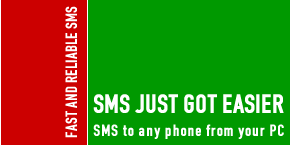|
More SMS information:
SMS stands for short messaging service. It's a way to send text over wireless phone systems. The text appears on your handheld's screen, or in the case of a cellular phone, on the phone's display. SMS messages are text messages of up to 160 characters.
No phone call is required to send or receive a text message. In fact, it is possible to send and receive messages on Handspring phones while on a voice call. SMS has been around since 1991, has gained huge usage in Europe and Asia, but has come into widespread use in North America recently. SMS is a universal text messaging system but has come to be associated with its prime adopter, the GSM/GPRS wireless networks.
How SMS works
SMS works on a store-and-forward basis. Instead of being sent directly to the recipient, SMS messages travel through several important nodes before reaching the recipient (skip this part if you find it boring; there's more good stuff below).
-
The SMS message is submitted to your wireless service provider's SMS Center.
-
After the message is processed internally, the SMS Center sends a request to the Home Location Register (HLR) and receives the routing information for the recipient.
-
The SMS Center sends the message to the Mobile Switching Center (MSC).
-
The MSC collects the recipient's information from the Visitor Location Register (VLR) and, sometimes, proceeds with an authentication operation.
-
The MSC forwards the message to a Mobile Server.
-
If the recipient has a Treo or VisorPhone, the SMS is placed on the SIM card until the handheld picks up the message and transfers it to the internal memory on the unit.
This is how Treos and VisorPhones can store hundreds of SMS messages, unlike ordinary GSM mobile phones that store only a few SMS messages.
Treo or VisorPhone owners may encounter the error message "Your SIM contains at least one SMS message. Do you want to move the message to your Visor?" See the related SMS article in our knowledgebase for details.
-
The MSC returns the outcome of the Forward Short operation to the SMS Center.
-
The SMS Center reports delivery status of the short message back to the sender.
What are the components of an SMS message?
The actual text of the SMS message isn't the only thing that's being transmitted. Here are the elements of a complete SMS transaction:
* Header: identifies the type of message.
* Service Center Timestamp
* Originator Address: the phone number of the sender
* Protocol Identifier
* Data Coding Scheme
* User Data Length: tells how long the message is
* User Data: the message itself (140 bytes: 160 7-bit characters, or 140 8-bit characters)
You won't see any of these components except the User Data (the message itself).
When you send an SMS to an email address, the message is still sent to the SMS Email center, but then it is relayed to the email server of the recipient. The recipient's email address is actually embedded in the User Data portion of the message, transparently on a Treo, or manually on a VisorPhone.
Why 160 Characters?
SMS was designed to deliver short bursts of data such as numerical pages. To avoid overloading the system with more than the standard forward-and-response operation, the inventors of SMS agreed on a 160-character maximum message size.
But the 160-character limit is not absolute. Length limitations may vary depending on the network, phone model and wireless carrier. Some phones don't allow you to keep typing once the 160-character limit is reached. You must send your message before continuing. However, some services will automatically break any message you send into chunks of 160 characters or less. So, you can type and send a long message, but it will be delivered as several messages.
SMS has several advantages. It is more discreet than a phone conversation, making it the ideal form for communicating when you don't want to be overheard. It is often less time-consuming to send a text message than to make a phone call or send an e-mail. SMS doesn't require you to be at your computer like e-mail and instant messaging (IM) do -- although some phones are equipped for mobile e-mail and IM services. SMS is also a convenient way for deaf and hearing-impaired people to communicate.
SMS is a store-and-forward service, meaning that when you send a text message to a friend, the message does not go directly to your friend's cell phone. The advantage of this method is that your friend's cell phone doesn't have to be active or in range for you to send a message. The message is stored in the SMSC (for days if necessary) until your friend turns his cell phone on or moves into range, at which point the message is delivered. The message will remain stored on your friend's SIM card until he deletes it.
In addition to person-to-person messages, SMS can be used to send a message to a large number of people at a time, either from a list of contacts or to all the users within a particular area. This service is called broadcasting and is used by companies to contact groups of employees or by online services to distribute news and other information to subscribers.
In a 2004 University of Plymouth study on the psychology of SMS users, researchers found that mobile phone users were primarily either "texters" or "talkers". Compared to the talkers, the texters sent nearly double the number of SMS messages and made less than half as many voice calls per month. The texters preferred SMS to voice calls for its convenience as well as for the ability to review a message before sending it.
Our online SMS service have come up with many uses for the service beyond just your typical person-to-person message. Because SMS doesn't overload the network as much as phone calls, it is frequently used by TV shows to let viewers vote on a poll topic or for a contestant. As a promotional tool, wireless carriers put up giant screens at concerts and other large-scale events to display text messages from people in the audience.
More SMS information can be found here: Why SMS | SMS explained | SMS using AT command | SMS reliability
| 

